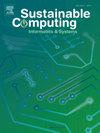FOG computing based energy efficient and secured iot data sharing using SGSOA and GMCC
IF 5.7
3区 计算机科学
Q1 COMPUTER SCIENCE, HARDWARE & ARCHITECTURE
引用次数: 0
Abstract
A Free and open-source Ghost (FOG) computing is a decentralized computing infrastructure, that helps in processing the data efficiently to end-user. None of the existing works concentrated on authorization between source, destination, and intermediate server during the Internet of Things (IoT) sensor data transmission. Therefore, the paper presents the authentication of the servers using Cholesky-HAVAL for secure IoT sensor data transmission. Initially, the IoT sensor devices are registered and logged into the FOG server. Next, the sensor nodes are clustered using Bray Pearson K-Means (BP-KMeans) clustering method. Through the cluster head, the IoT data is sensed, and the attributes are extracted. The sensed data is then secured using Gauss Montgomery Curve Cryptography (GMCC). The secured data is stored in the Hadoop Distributed File System (HDFS) FOG server. Here, the data is mapped using BP-KMeans and then reduced using the Schwefel Group Search Optimization Algorithm (SGSOA). Meanwhile, Merkle Tree (MT) is created using Cholesky-HAVAL regarding the sensor data attributes, IoT sensor ID (Identification), and FOG server ID. Next, to retrieve the sensor data, the user registers and logs into the server. Then, the user gives a query request for accessing the data present in the cloud. The attributes are extracted from the query, and using SGSOA, the query is optimized. Finally, the hashcode verification is done regarding the attributes from sensed data and the query. The IoT data is thus retrieved for the verified hashcodes. Thus, the proposed work clustered the sensor nodes in 4578 ms and generated the hashcode in 1476 ms.
使用SGSOA和GMCC进行基于FOG计算的节能和安全的物联网数据共享
一个自由和开源的Ghost (FOG)计算是一个去中心化的计算基础设施,它有助于有效地处理最终用户的数据。现有的工作都没有集中在物联网传感器数据传输过程中源、目的和中间服务器之间的授权。因此,本文提出了使用Cholesky-HAVAL对服务器进行身份验证,以确保物联网传感器数据的安全传输。最初,物联网传感器设备注册并登录到FOG服务器。其次,采用布雷-皮尔逊k -均值(BP-KMeans)聚类方法对传感器节点进行聚类。通过簇头感知物联网数据,提取属性。然后使用高斯蒙哥马利曲线加密(GMCC)保护感测数据。安全数据存储在HDFS (Hadoop Distributed File System) FOG服务器中。在这里,数据使用BP-KMeans进行映射,然后使用Schwefel Group Search Optimization Algorithm (SGSOA)进行约简。同时,根据传感器数据属性、物联网传感器ID (Identification)和FOG服务器ID,使用Cholesky-HAVAL创建默克尔树(MT)。接下来,为了检索传感器数据,用户注册并登录到服务器。然后,用户给出访问云中的数据的查询请求。从查询中提取属性,并使用SGSOA对查询进行优化。最后,对来自感测数据和查询的属性进行哈希码验证。因此,通过验证的哈希码检索物联网数据。因此,提出的工作在4578 ms内对传感器节点进行聚类,并在1476 ms内生成哈希码。
本文章由计算机程序翻译,如有差异,请以英文原文为准。
求助全文
约1分钟内获得全文
求助全文
来源期刊

Sustainable Computing-Informatics & Systems
COMPUTER SCIENCE, HARDWARE & ARCHITECTUREC-COMPUTER SCIENCE, INFORMATION SYSTEMS
CiteScore
10.70
自引率
4.40%
发文量
142
期刊介绍:
Sustainable computing is a rapidly expanding research area spanning the fields of computer science and engineering, electrical engineering as well as other engineering disciplines. The aim of Sustainable Computing: Informatics and Systems (SUSCOM) is to publish the myriad research findings related to energy-aware and thermal-aware management of computing resource. Equally important is a spectrum of related research issues such as applications of computing that can have ecological and societal impacts. SUSCOM publishes original and timely research papers and survey articles in current areas of power, energy, temperature, and environment related research areas of current importance to readers. SUSCOM has an editorial board comprising prominent researchers from around the world and selects competitively evaluated peer-reviewed papers.
 求助内容:
求助内容: 应助结果提醒方式:
应助结果提醒方式:


